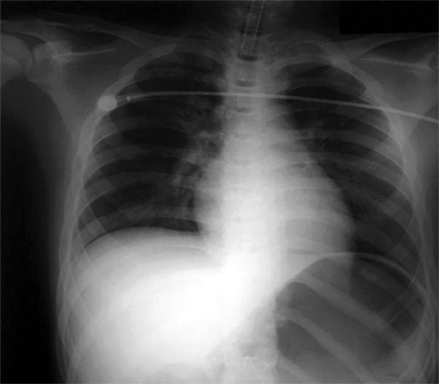Yonsei Med J.
2005 Apr;46(2):305-308. 10.3349/ymj.2005.46.2.305.
Pulmonary Edema following Phenylephrine Intranasal Spray Administration during the Induction of General Anesthesia in a Child
- Affiliations
-
- 1Department of Anesthesiology and Pain Medicine, Research Institute of Clinical Medicine, Chonbuk National University Medical School and Hospital, Jeonju, Korea. sjs6803@hanmail.net
- KMID: 1734061
- DOI: http://doi.org/10.3349/ymj.2005.46.2.305
Abstract
- Topical phenylephrine, an agent used to facilitate nasotracheal intubation and prevent nasal mucosal bleeding, can cause severe hypertension in some patients, secondary to its stimulation of alpha-adrenergic receptors. Moreover, a high incidence of pulmonary edema is found in patients whose phenylephrine administration is followed by treatment with beta-blocking agents. We report a case of acute pulmonary edema in a pediatric patient who developed severe hypertension after the inadvertent administration of a large dose of topical nasal phenylephrine, followed by beta-adrenergic antagonists (esmolol).
MeSH Terms
Figure
Cited by 1 articles
-
A comparison of the effects of epinephrine and xylometazoline in decreasing nasal bleeding during nasotracheal intubation
Jaegyok Song
J Dent Anesth Pain Med. 2017;17(4):281-287. doi: 10.17245/jdapm.2017.17.4.281.
Reference
-
1. Groudine SB, Hollinger I, Jones J, DeBouno BA. The Phenylephrine Advisory Committee. New York State guidelines on the topical use of phenylephrine in the operating room. Anesthesiology. 2000. 92:859–864.2. Kalyanaraman M, Carpenter RL, McGlew MJ, Guertin SR. Cardiopulmonary compromise after use of topical and submucosal alpha-agonists: Possible added complication by the use of beta-blocker therapy. Otolaryngol Head Neck Surg. 1997. 117:56–61.3. Kademani D, Voiner JL, Quinn PD. Acute hypertensive crisis resulting in pulmonary edema and myocardial ischemia during orthognathic surgery. J Oral Maxillofac Surg. 2004. 62:240–243.4. Riegle EV, Gunter JB, Lusk RP, Muntz HR, Weiss KL. Comparison of vasoconstrictors for functional endoscopic sinus surgery in children. Laryngoscope. 1992. 102:820–823.5. Van Der Spek AF, Hantler CB. Phenylephrine eyedrops and anesthesia. Anesthesiology. 1986. 64:812–814.6. Baldwin FJ, Morley AP. Intraoperative pulmonary oedema in a child following systemic absorption of phenylephrine eyedrops. Br J Anaesth. 2002. 88:440–442.7. Greher M, Harmann T, Winkler M, Zimpfer M, Crabnor CM. Hypertension and pulmonary edema associated with subconjunctival phenylephrine in a 2-month-old child during cataract extraction. Anesthesiology. 1998. 88:1394–1396.8. Shanks RG. Clinical pharmacology of vasodilatory beta-blocking drugs. Am Heart J. 1991. 121:1006–1011.9. Wray DW, Formes KJ, Weiss MS, O-Yurvati AH, Raven PB, Zhang R, et al. Vagal cardiac function and arterial blood pressure stability. Am J Physiol Heart Circ Physiol. 2001. 281:H1870–H1880.10. Park JW, Wirtz JH, May E, Mertens S, Braun P, Heinzler R, et al. Enoximone therapy as pharmacological bridging to cardiac transplantation. Yonsei Med J. 1993. 34:63–70.11. Nam YT, Kim JS, Park KW. Effect of hypotensive anesthesia with sodium nitroprusside or isoflurane on hemodynamic and metabolic changes. Yonsei Med J. 1992. 33:320–325.
- Full Text Links
- Actions
-
Cited
- CITED
-
- Close
- Share
- Similar articles
-
- Unexpected Pulmonary Edema Associated with an Intranasal Spray of Phenylephrine during the Induction of General Anesthesia: A case report
- Use of Midazolam Intranasal Spray for Dental Treatment of Autism Patients
- Pulmonary Edema during General Anesthesia for Cesarean Seetion of Pre-eclampsia Patient
- Noncardiogenic Pulmonary Edema Related to Airway Obstruction
- Negative pressure pulmonary edema after endotracheal tube extubation during recovery of general anesthesia in a pediatric patient with cerebral palsy



